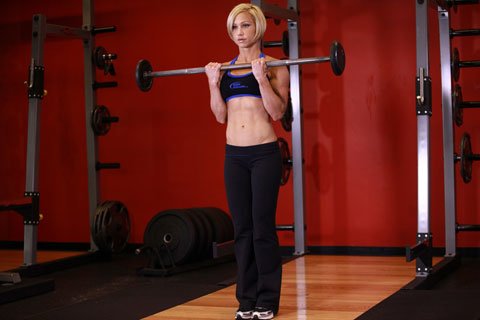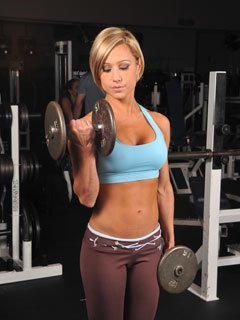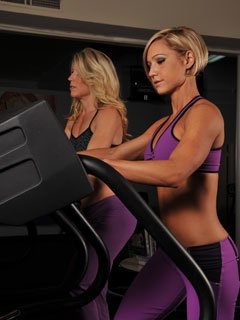The myths about women's weight training and female bodybuilding do not ever seem to go away. My goal with this article is to share the real facts about girls and the weight room.
Training Myth 1: Weight Training Makes You Bulky
Due to the fact that women do not and cannot naturally produce as much testosterone (one of the main hormones responsible for increasing muscle size) as males do, it is impossible for a woman to gain huge amounts of muscle mass unless anabolic steroids are used in conjunction with an extremely aggressive weight training program and bulking diet.
Women who conduct weight training without the use of steroids get the firm and fit cellulite-free looking body that they're looking for provided that they follow a good nutrition program and cardiovascular workout as well.

 Click To Enlarge.
Click To Enlarge. Women Who Conduct Weight Training Get The Firm
And Fit Cellulite-Free Body That They're Looking For.
Training Myth 2: Exercise Increases Your Chest Size
Sorry girls. Women's breasts are composed mostly of fatty tissue. Therefore, it is impossible to increase breast size through weight training. As a matter of fact, if you go below 12 percent body fat, your breast size will decrease.
Weight training does increase the size of the back, so this misconception probably comes from confusing an increase in back size with an increase in cup size. The only way to increase your breast size is by gaining fat or getting breast implants.
Training Myth 3: Weight Training Makes You Stiff and Muscle-Bound
If you perform all exercises through their full range of motion, flexibility will increase. Exercises like flyes, stiff-legged deadlifts, dumbbell presses, and chin-ups stretch the muscle in the bottom range of the movement. Therefore, by performing these exercises correctly, your stretching capabilities will increase.
Training Myth 4: If You Stop Weight Training Your Muscles Turn Into Fat
This is like saying that gold can turn into brass. Muscle and fat are two totally different types of tissue. What happens many times is that when people decide to go off their weight training programs they start losing muscle due to inactivity (use it or lose it) and they also usually drop the diet as well.
Therefore bad eating habits combined with the fact that their metabolism is lower due to inactivity, and lower degrees of muscle mass, give the impression that the subject's muscle is being turned into fat while in reality what is happening is that muscle is being lost and fat is being accumulated.
Training Myth 5: Weight Training Turns Fat Into Muscle
More alchemy. This is the equivalent of saying that you can turn any metal into gold; don't we wish!
The way a body transformation occurs is by gaining muscle through weight training and losing fat through aerobics and diet simultaneously. Again, muscle and fat are very different types of tissue. We cannot turn one into the other.


 Click To Enlarge.
Click To Enlarge. Muscle Is Gained Through Weight Training
And Fat Is Lost Through Aerobics And Diet.
Training Myth 6: As Long As You Exercise You Can Eat Anything That You Want
I wish this were true! However, this could not be further from the truth. Our individual metabolism determines how many calories we burn at rest and while we exercise. If we eat more calories than we burn on a consistent basis, our bodies will accumulate these extra calories as fat regardless of the amount of exercise that we do.
This myth may have been created by people with such high metabolic rates (hardgainers) that no matter how much they eat or what they eat, they rarely meet or exceed the amount of calories that they burn in one day unless they put their mind to doing so. Therefore, their bodyweight either remains stable or goes down.

 Click To Enlarge.
Click To Enlarge. Our Bodies Will Accumulate Extra Calories
As Fat Regardless Of The Amount Of Exercise We Do.
Training Myth 7: Women Only Need To Do Cardio & If They Decide To Lift Weights, They Should Be Very Light
First of all, if you only did cardio then muscle and fat would be burned for fuel. A woman needs to do weights in order to get the muscle building machine going and thus prevent any loss of muscle tissue.
Keep in mind also that the muscle gained through weight training will ultimately be responsible for toning your physique.
Women that only concentrate on cardio will have a very hard time achieving the look that they want. As far as the lifting of very light weights, this is just more nonsense. Muscle responds to resistance and if the resistance is too light, then there will be no reason for the body to change.
Women Should Train Hard
I have trained with girls that train as hard as I do and they look nothing but feminine. If you want to look great, don't be afraid to pick up the weights and lift hard!
4-Day Training Routine For Women: Emphasizing The Lower Body
This routine is designed for a woman that wants to emphasize the lower body and shoulders.
Note: Rest 60 seconds in between sets.
Day 1: Thighs/Hamstrings/Glutes/Calves
- Leg Extensions: 3 sets of 13-15 repetitions
- Leg Press: 3 sets of 10-12 repetitions
- Barbell Squats: 3 sets of 8-10 repetitions
- Lunges: 3 sets of 13-15 repetitions
- Lying Leg Curls: 3 sets of 10-12 repetitions
- Dumbbell Stiff-Legged Deadlifts: 3 sets of 8-10 repetitions
- Standing Calf Raises: 3 sets of 10-12 repetitions
- Seated Calf Raises: 3 sets of 13-15 repetitions
Day 2: Back/Chest/Shoulders
- Wide-Grip Pull-ups: 4 sets of 8-10 repetitions
- Reverse Pull-downs: 3 sets of 10-12 repetitions
- Low-Pulley Rows: 3 sets of 13-15 repetitions
- Incline Dumbbell Bench Press: 4 sets of 8-10 repetitions
- Chest Dips: 3 sets of 10-12 repetitions
- Incline Flyes: 3 sets of 13-15 repetitions
- Bent-Over Laterals: 3 sets of 13-15 repetitions
- Upright Rows: 3 sets of 10-12 repetitions
Day 3: Abs/Cardio
- Swiss Ball Crunches: 3 sets of 15-25 reps
- Leg Raises: 3 sets of 15-25 reps
- Bicycle Crunches: 3 sets of 15-25 reps
- Cardio: 30-45 minutes
Day 4: Thighs/Hamstrings/Glutes/Calves
- Barbell Squats: 3 sets of 8-10 repetitions
- Leg Press: 3 sets of 10-12 repetitions
- Leg Extensions: 3 sets of 13-15 repetitions
- Standing Leg Curls: 4 sets of 10-12 repetitions
- Butt Blaster: 4 sets of 13-15 repetitions
- Calf Raises on Leg Press Machine: 3 sets of 10-12 repetitions
Day 5: Shoulders/Biceps/Triceps
- Dumbbell Shoulder Press: 4 sets of 8-10 repetitions
- Lateral Raises: 3 sets of 10-12 repetitions
- Rear-Delt Machine: 3 sets of 13-15 repetitions
- Incline Dumbbell Curls: 3 sets of 8-10 repetitions
- Incline Hammer Curls: 3 sets of 10-12 repetitions
- Concentration Curls: 3 sets of 10-12 repetitions
- Triceps Dips on Bench: 3 sets of 13-15 repetitions
- Overhead Triceps Extensions: 3 sets of 10-12 repetitions
- Triceps Push-downs: 3 sets of 8-10 repetitions
Days 6 And 7: Abs/Cardio
- Swiss Ball Crunches: 3 sets of 15-25 reps
- Leg Raises: 3 sets of 15-25 reps
- Bicycle Crunches: 3 sets of 15-25 reps
- Cardio: 30-45 minutes
Choose any type of cardiovascular activity that you enjoy such as recumbent bike, walking outside or on a treadmill, elliptical machine, stair climber, etc.
In order for aerobic exercise to be effective, it needs to be performed within the fat-burning zone. The fat burning zone is the zone at which you are doing enough work to burn fat. Your pulse (how fast your heart is beating per minute) determines this zone.
The fat burning zone formula is the following:
The result of your formula will give you an approximate value of how fast your heart should be beating per minute.
For example, a 20-year-old would need to reach a pulse in the neighborhood of 150 beats per minute in order to be in the fat burning zone. It is important to remember that this is not an absolute figure, this is an approximation. So as long as you are plus or minus 10 beats from the number that the formula provides you with, then you are doing alright.
